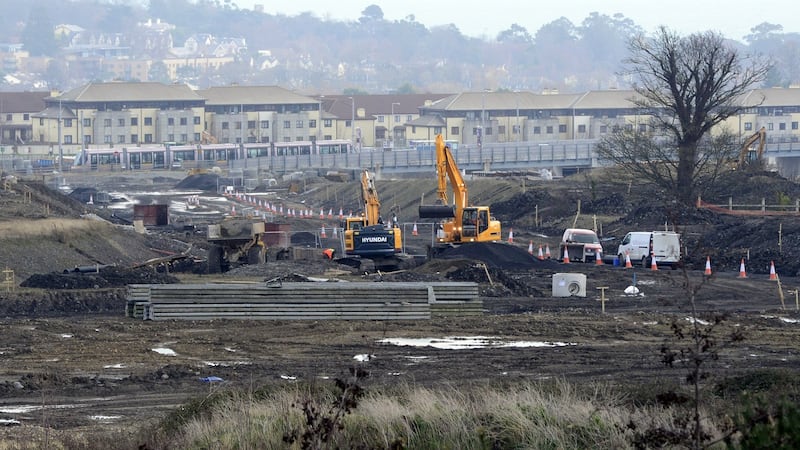Friday is the deadline by which 15 local authorities must submit their applications to central government for special infrastructure funding for 34 housing projects.
The projects, mainly in Dublin and Cork, but also in east coast and midland commuter counties, have the potential to deliver 69,240 new homes, almost 28,000 of them by 2021.
However, in some instances, wrangling over the price at which the homes will be sold threatens the funding, as local authorities and developers have to date been unable to agree how many of the homes can be classified as “affordable”, a key government demand, and also what constitutes affordable.
In March, the Government set aside €226 million as a Local Infrastructure Housing Activation Fund (LIHAF) administered by the Department of Housing, Planning and Local Government.
The money was to be spent by local authorities that were building, or reimbursing developers for building, major access roads, bridges and laying on other development-critical supplies such as water to major development sites that had become moribund since the property and banking crisis.
Approved in principle
Thirty-four such sites were identified in 15 local authority areas and approved in principle as recipients of funding. Councils involved include Cork City and County, Dublin City, Dún Laoghaire-Rathdown, Fingal and South County Dublin, Clare, Kildare, Kilkenny, Limerick, Louth, Meath and Westmeath, Tipperary and Waterford.
In return for infrastructure, the Government wants a proportion of the homes built to be affordable housing.
The Department of Housing originally said 40 per cent of the homes in schemes availing of infrastructure assistance should be sold for “at least 10 per cent below the cost of market housing” with the expressed aim that this would include houses “under €300,000 in Dublin”.
“It is up to the relevant local authorities to negotiate with the developers to deliver the affordable houses, and these are in addition to the ‘Part 5’ 10 per cent [social housing] that must accompany the development also,” said a Department of Housing spokesman.

“In some of the south Dublin sites, the developers are having difficulty delivering affordable housing because of the overall development costs associated with the area.
"It is easier for developers to deliver under the scheme in, say, Adamstown, where site costs and sale prices are lower. But in other places, such as South Dublin and Dún Laoghaire, developers are saying they can't deliver affordable housing for €300,000."
While Friday is the deadline for funding applications on the basis of agreement between local authorities and developers, it is understood the department will be flexible and enter discussions with local authorities in the coming weeks to “tweak” plans as required.
The department has acknowledged “it may not be always possible” to deliver housing for €300,000 a unit, when current average prices were considerably higher.
As an alternative, the department asked developers to demonstrate a “before and after” price, indicating how much the new homes would cost without the State aid, and how much they would sell for with it.
The largest grouping of approved LIHAF schemes is in Dún Laoghaire-Rathdown, where four sites – Cherrywood, Clay Farm, Kilternan Glenamuck and Woodbrook Shanganagh – have the potential to deliver 14,800 new homes, together with a huge shopping complex at Cherrywood.
South Dublin is close behind with three large schemes, in Adamstown, Clonburris and Corkagh Grange, where 11,500 new homes are due to be built. Next comes Cork County, where four proposed builds, at Ballincollig, Carrigaline, Glanmire and Midleton, could deliver 8,400 new homes.
Three schemes in Fingal, north Co Dublin – Baldoyle Stapolin, Donabate and Oldtown Mooretown – have the potential to deliver 6,900 new homes.
For the four major proposed developments in Dún-Laoghaire Rathdown, the Government is prepared to spend over €15 million on infrastructure for Cherrywood. This would include a new access route between Cherrywood and the N11 at the north end of the development.
The Cherrywood main developer, Hines, a Houston-based global real estate investment and development company, has started putting in infrastructure ahead of building shops at the Bride’s Glen Luas stop end of the development, apartments and homes.
‘Interminable foot-dragging’
Informed observers bemoan what they see as interminable foot-dragging by Dún Laoghaire-Rathdown. It was taking “a lifetime” to get the planning sorted out, said one, adding, however, that 76 issues have been whittled down to 10.
“Dún Laoghaire-Rathdown are the most inefficient local authority,” said a private planning consultant. “They are very hesitant and defensive and seem to make a mountain out of a molehill. In Cherrywood, you have a developer, you have the money, but you can’t get decisions from the local authority.
“They should be putting rocket fuel into this.”
However, for its part, the council, noting the Friday deadline, said a draft grant agreement between it and developers would be submitted to the department on Friday on all four approval projects in its area.
A council spokeswoman said: “Our submission for each site will include a schedule of the infrastructure delivery programme, a housing delivery schedule, provision for land ownership transfer details to allow for the building of the infrastructure by DLR, and a proposal from the respective LIHAF landowners on... the affordability dimension/cost reduction by way of a form of undertaking in accordance with the current clause of the grant agreement.”
If approved by the department for grant, apart from the €15.19 million for new roads and a bridge in Cherrywood, €10.15 million would be spent on new roads at Clay farm in Ballyogan; €10.5 million on roads and the diversion of an ESB line at Kilternan/Glenamuck, and €4.16 million on a road and junction at Woodbrook, which will also get its own Dart station.












